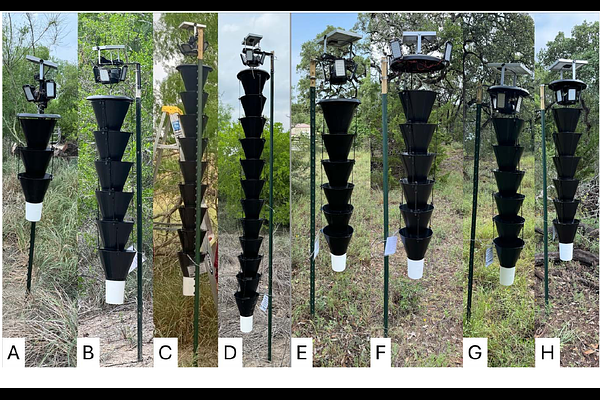Advancing the design of the kissing bug kill trap for surveillance of triatomines

Advancing the design of the kissing bug kill trap for surveillance of triatomines
Tian, Y.; Fernandez-Santos, N. A.; Juarez, J. G.; Esquivel, H.; Moller-Vasquez, A. M.; Granados-Presa, M.; Echeverria, A.; Pennington, P. M.; Fimbres-Macias, J. P.; Roachell, W.; Lenhart, P.; Casey, T.; Keck, M. E.; Hodo, C. L.; Downs, C. H.; Sittenauer, S. C.; Nevins, C.; Balasubramanian, S.; Angulo, C.; Palacios-Cardiel, C.; Gaxiola-Robles, R.; Zenteno-Savin, T.; Hamer, S. A.; Borden, J. H.; Banfield, M. G.; Padilla, N.; Hamer, G. L.
AbstractStandardized surveillance and control of kissing bugs (Hemiptera: Reduviidae: Triatominae), the insect vectors of the Chagas disease parasite Trypanosoma cruzi, which causes Chagas disease, remains difficult. The Kissing Bug Kill Trap consists of solar powered LED lights mounted over a column of black funnels. It operates autonomously to capture, kill and preserve triatomines. We conducted experiments from 2022-2024 testing potential ways to improve trap performance, ease of deployment, and minimize cost. Thirteen prototypes evaluated in Texas, Guatemala, and Mexico captured 1,531 triatomines. In 2022-2023 we selected a six-funnel trap suspended from a single support pole with an angle bracket, and with four LED lights and a solar panel mounted above the rain-guard, as a reference trap. In 2023, traps with smaller funnels, blue funnels, and blue lights were inferior to the reference trap based on high by-catch of other arthropods and/or fewer triatomines caught per day. In 2024, traps with more or fewer than six funnels or with LED lights mounted on or below the rain guard did not outperform the reference trap. The experiments added five new triatomine species to the four already known to be caught by the Kissing Bug Kill Trap and revealed differences and similarities in phenology of dispersal flights of Triatoma gerstaeckeri over a three-year period in Texas. The reference trap was selected as the pre-commercial prototype, based on its suitability for triatomine surveillance and potential for reducing the risk of T. cruzi infection by intercepting dispersing adult triatomines before they reach human habitats.